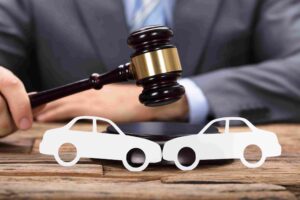Joe Horrox Law is a renowned legal firm that handles car accident claims in Florida. With a wealth of experience and a team of skilled attorneys, Joe Horrox Law has established itself as a trusted advocate for accident victims seeking justice and fair compensation.
Understanding the different types of car accidents is essential for individuals involved in such incidents, as it can significantly impact their claims. By delving into the specifics of each type of car accident, victims can better understand liability, insurance coverage, and the damages typically associated with these incidents.
This knowledge empowers individuals to make informed decisions and seek the appropriate legal representation to protect their rights and pursue the compensation they deserve.
If you have additional questions, we are here to help. Our car accident lawyer can help you get the full compensation you are entitled to.
Rear-End Collisions
Rear-end collisions occur when one vehicle strikes the back of another vehicle in front of it. They are one of the most common car accidents on the roads. Understanding the dynamics of rear-end collisions and their impact on insurance claims is crucial for accident victims.
Causes of Rear-End Collisions
Several factors contribute to rear-end collisions. Distracted driving, such as texting or talking on the phone while driving, diverts attention from the road and increases the risk of rear-end collisions. Tailgating, which refers to following another vehicle too closely, reduces the driver’s reaction time and can lead to rear-end accidents. Other causes include aggressive driving, impaired driving, and adverse weather conditions.
Effects on Claims
When it comes to rear-end collisions, liability is often straightforward. The driver who rear-ends another vehicle is typically considered at fault for failing to maintain a safe distance or exercise proper control over their vehicle. This means that the driver in the rear is usually responsible for the damages and injuries caused.
Regarding insurance coverage, rear-end the at-fault driver’s liability insurance generally covers collisions. However, if the at-fault driver is uninsured or underinsured, the injured party may need to rely on their uninsured/underinsured motorist coverage.
Damages Associated with Rear-End Collisions
Whiplash is a common injury sustained in rear-end collisions. It occurs when the impact abruptly forces the head and neck to jerk forward and backward. Whiplash can result in severe neck pain, headaches, and long-term complications.
Additionally, rear-end collisions often cause property damage, ranging from minor bumper dents to more significant structural damage.
Intersection Accidents
Intersection accidents occur when two or more vehicles collide at the intersection of two or more roads. These types of accidents are particularly dangerous due to the high speeds and multiple points of potential impact. Understanding the dynamics of intersection accidents and their impact on insurance claims is crucial for accident victims.
Causes of Intersection Accidents
Several factors contribute to intersection accidents. Running red lights is a prevalent cause, where a driver fails to stop at a traffic signal and collides with another vehicle lawfully proceeding through the intersection. Failure to yield is another common cause, where a driver fails to give the right of way to another vehicle, often resulting in side-impact collisions. Distracted driving, speeding, and impaired driving can lead to intersection accidents.
Effects on Claims
Determining fault in intersection accidents can be complex. Accident reconstruction, witness statements, and traffic camera footage may be necessary to establish which party was responsible for the collision. Comparative negligence laws in Florida can affect the compensation an accident victim can receive based on their degree of fault. Negotiating with insurance companies becomes crucial to ensure a fair settlement, as insurers may attempt to minimize liability.
Damages Associated with Intersection Accidents
Intersection accidents often result in severe bodily injuries due to the nature of the collisions. Common injuries include broken bones, spinal cord injuries, traumatic brain injuries, and internal organ damage. These injuries can have long-term consequences, requiring extensive medical treatment and rehabilitation and impacting the victim’s quality of life. Additionally, property damage to vehicles involved in intersection accidents can range from minor repairs to total loss.
T-Bone Collisions
T-bone collisions, also known as side-impact or broadside collisions, occur when the front end of one vehicle crashes into the side of another vehicle at a perpendicular angle, resembling the shape of a “T.” Understanding the dynamics of T-bone collisions and their impact on insurance claims is crucial for accident victims.
Causes of T-Bone Collisions
Several factors contribute to T-bone collisions. Failure to stop at intersections, whether due to running a red light or disregarding a stop sign, is a common cause. Improper turning, such as making an illegal left turn or failing to yield the right of way, can also lead to T-bone accidents. Additionally, distracted driving, speeding, and driving under the influence of alcohol or drugs increase the risk of T-bone collisions.
Effects on Claims
Establishing liability in T-bone collisions can be critical for a claim resolution. Accident reconstruction, eyewitness testimonies, and traffic camera footage may be necessary to determine which driver was at fault. Proving negligence is crucial in securing compensation for the injured party. Both drivers may share some of the blame in some cases, resulting in a comparative negligence evaluation.
Damages Associated with T-Bone Collisions
T-bone collisions often result in severe injuries due to the direct impact on the side of the vehicle. Common injuries include fractures, head trauma, spinal cord injuries, and internal organ damage. These injuries may require extensive medical treatment, surgeries, and long-term rehabilitation. Additionally, T-bone collisions frequently cause extensive damage to vehicles involved, ranging from significant structural damage to total loss.
Sideswipe Accidents
Sideswipe accidents occur when two vehicles traveling parallel to each other make contact. These collisions typically involve the sides of the vehicles, often resulting in scrapes or minor damage. Understanding the dynamics of sideswipe accidents and their impact on insurance claims is essential for accident victims.
Causes of Sideswipe Accidents
Sideswipe accidents can be caused by various factors, including lane-changing errors, where a driver fails to check blind spots or improperly changes lanes. Merging mistakes, such as misjudging the distance or speed of another vehicle while merging, can also lead to sideswipe collisions. In some cases, distracted driving or aggressive maneuvers contribute to these accidents.
Effects on Claims
Determining fault in sideswipe accidents can be challenging, as both drivers may share some responsibility. It is crucial to gather evidence, such as witness statements, photographs, or surveillance footage, to establish liability. Comparative negligence laws may come into play, impacting the compensation a victim can receive based on their level of fault. Pursuing a claim for a sideswipe accident requires navigating the claims process and negotiating with insurance companies.
Damages Associated with Sideswipe Accidents
Sideswipe accidents often result in minor injuries, such as bruises, strains, or sprains, as the impact is typically less severe than other collisions. However, seeking medical attention to assess and document any injuries is essential. Additionally, sideswipe accidents can cause cosmetic damage to vehicles, including scratches, dents, or broken side mirrors.
Head-On Collisions
Head-on collisions occur when two vehicles traveling in opposite directions collide with their front ends, resulting in a direct impact. These collisions are among the most severe and dangerous types of car accidents. Understanding the dynamics of head-on collisions and their impact on insurance claims is crucial for accident victims.
Causes of Head-On Collisions
Several factors contribute to head-on collisions. Wrong-way driving, where a driver enters a road in the opposite direction of traffic flow, is a common cause. Overtaking errors, such as unsafely attempting to pass another vehicle or misjudging the distance, can also lead to head-on accidents. Factors such as distracted driving, impaired driving, or hazardous road conditions can exacerbate the risk of head-on collisions.
Effects on Claims
Head-on collisions present complex liability issues. Determining fault requires a thorough investigation, which may involve accident reconstruction, witness statements, and skid marks or other evidence analysis. In some cases, both drivers may share a portion of the blame. These complexities make it crucial to have skilled legal representation to navigate the claims process effectively. Insurance companies will scrutinize the circumstances and damages to assess liability and negotiate settlements.
Damages Associated with Head-On Collisions
Head-on collisions often result in catastrophic injuries due to the high forces involved. These injuries can include severe head trauma, spinal cord injuries, multiple fractures, internal organ damage, or limb amputation. The extensive impact of head-on collisions can lead to long-term disabilities, requiring extensive medical treatment, rehabilitation, and ongoing care.
Additionally, vehicles involved in head-on collisions are often severely damaged, with some cases resulting in total vehicle loss.
Understanding Your Options After a Florida Car Accident
Understanding the various types of car accidents and their impact on insurance claims is crucial for accident victims seeking justice and fair compensation. By familiarizing themselves with these aspects, individuals can more effectively navigate the complex world of car accident claims.
Consulting with a knowledgeable car accident attorney, like those at Joe Horrox Law, can provide invaluable support in protecting their rights, pursuing fair compensation, and obtaining the closure and financial recovery they deserve after a car accident. Call our office at (386) 200-9216 to schedule a free consultation.

